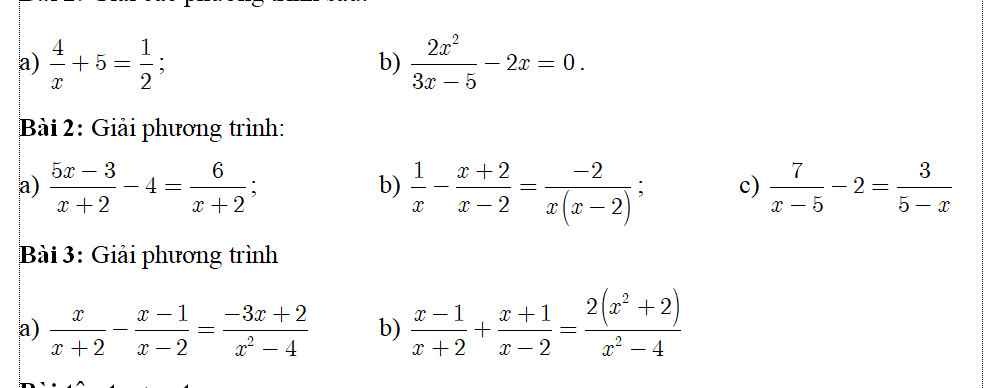
Hãy nhập câu hỏi của bạn vào đây, nếu là tài khoản VIP, bạn sẽ được ưu tiên trả lời.


8. Gọi số vé loại I và loại II lần lượt là x và y
ĐK: x,y > 0
Tổng số vé bán được là 500 vé `=> x+y=500` (1)
Tổng số tiền vé bán được là 44500000 đồng nên ta có pt:
`100000x+75000y=44500000`
`<=>4x+3y=1780` (2)
Từ (1) và (2) ta có hpt: \(\left\{{}\begin{matrix}x+y=500\\4x+3y=1780\end{matrix}\right.\Leftrightarrow\left\{{}\begin{matrix}x=280\\y=220\end{matrix}\right.\left(tm\right)\)
Vậy: ...

6. Gọi nhóm bạn trẻ có `x` (người)
ĐK: x ∈ N*
Mỗi người góp số tiền là: \(\dfrac{240}{x}\) (triệu)
Sau khi thêm thì tổng số người có trong nhóm là: \(x+2\) (người)
Sau khi thêm thì mỗi người góp: \(\dfrac{240}{x+2}\) (triệu)
Mà sau khi thêm người thì số tiền góp của mỗi người giảm đi 4 triệu nên ta có pt:
\(\dfrac{240}{x}-4=\dfrac{240}{x+2}\\ \Leftrightarrow\dfrac{240}{x}-\dfrac{240}{x+2}=4\\ \Leftrightarrow\dfrac{240\left(x+2\right)-240x}{x\left(x+2\right)}=4\\ \Leftrightarrow\dfrac{480}{x\left(x+2\right)}=4\\ \Leftrightarrow4x\left(x+2\right)=480\\ \Leftrightarrow x\left(x+2\right)=120\\ \Leftrightarrow x^2+2x-120=0\\ \Leftrightarrow\left(x-10\right)\left(x+12\right)=0\\ \Leftrightarrow\left[{}\begin{matrix}x=10\left(tm\right)\\x=-12\left(ktm\right)\end{matrix}\right.\)
Vậy: ...

a) R + R' = 5 + 6 = 11 > 18
=> (O) và (O') không giao nhau
b) R + R' = 9 + 3 = 12 > 2
=> (O) và (O') cắt nhau
c) R + R' = 8 + 5 = 13 = OO'
=> (O) và (O') tiếp xúc nhau
d) R + R' = 15 + 4 = 19 > 17
=> (O) và (O') cắt nhau

Bài 2:
\(a.\dfrac{5x-3}{x+2}-4=\dfrac{6}{x+2}\left(x\ne-2\right)\\ \Leftrightarrow\dfrac{5x-3}{x+2}-\dfrac{6}{x+2}=4\\ \Leftrightarrow\dfrac{5x-3-6}{x+2}=4\\ \Leftrightarrow\dfrac{5x-9}{x+2}=4\\ \Leftrightarrow5x-9=4\left(x+2\right)\\ \Leftrightarrow5x-9=4x+8\\ \Leftrightarrow5x-4x=8+9\\ \Leftrightarrow x=17\left(tm\right)\)
\(b.\dfrac{1}{x}-\dfrac{x+2}{x-2}=\dfrac{-2}{x\left(x-2\right)}\left(x\notin\left\{0;2\right\}\right)\\ \Leftrightarrow\dfrac{x-2}{x\left(x-2\right)}-\dfrac{x\left(x+2\right)}{x\left(x-2\right)}=\dfrac{-2}{x\left(x-2\right)}\\ \Leftrightarrow x-2-x\left(x+2\right)=-2\\ \Leftrightarrow x-2-x^2-2x=-2\\ \Leftrightarrow-x^2-x=0\\ \Leftrightarrow x\left(x+1\right)=0\\ \Leftrightarrow\left[{}\begin{matrix}x=0\left(ktm\right)\\x=-1\left(tm\right)\end{matrix}\right.\)
\(c.\dfrac{7}{x-5}-2=\dfrac{3}{5-x}\left(x\ne5\right)\\ \Leftrightarrow\dfrac{7}{x-5}-2-\dfrac{3}{x-5}=0\\ \Leftrightarrow\dfrac{7}{x-5}+\dfrac{3}{x-5}=2\\ \Leftrightarrow\dfrac{10}{x-5}=2\\ \Leftrightarrow x-5=\dfrac{10}{2}=5\\\Leftrightarrow x=5+5\\ \Leftrightarrow x=10\left(tm\right)\)
Bài 3:
a: ĐKXĐ: \(x\notin\left\{-2;2\right\}\)
\(\dfrac{x}{x+2}-\dfrac{x-1}{x-2}=\dfrac{-3x+2}{x^2-4}\)
=>\(\dfrac{x\left(x-2\right)-\left(x-1\right)\left(x+2\right)}{\left(x-2\right)\left(x+2\right)}=\dfrac{-3x+2}{\left(x-2\right)\left(x+2\right)}\)
=>\(x^2-2x-\left(x^2+x-2\right)=-3x+2\)
=>-3x+2=-3x+2
=>0x=0(luôn đúng)
Vậy: \(x\in R\backslash\left\{-2;2\right\}\)
b: ĐKXĐ: \(x\notin\left\{2;-2\right\}\)
\(\dfrac{x-1}{x+2}+\dfrac{x+1}{x-2}=\dfrac{2\left(x^2+2\right)}{x^2-4}\)
=>\(\dfrac{\left(x-1\right)\left(x-2\right)+\left(x+1\right)\left(x+2\right)}{\left(x+2\right)\left(x-2\right)}=\dfrac{2\left(x^2+2\right)}{x^2-4}\)
=>\(x^2-3x+2+x^2+3x+2-2x^2-4=0\)
=>0x=0(luôn đúng)
vậy: \(x\in R\backslash\left\{2;-2\right\}\)

\(b)\left\{{}\begin{matrix}x-\dfrac{y}{2}=\dfrac{1}{2}\\\dfrac{x}{3}-2y=-\dfrac{5}{3}\end{matrix}\right.\Leftrightarrow\left\{{}\begin{matrix}2x-y=1\\x-6y=-5\end{matrix}\right.\\ \Leftrightarrow\left\{{}\begin{matrix}2x-y=1\\2x-12y=-10\end{matrix}\right.\Leftrightarrow\left\{{}\begin{matrix}11y=11\\2x-y=1\end{matrix}\right.\Leftrightarrow\left\{{}\begin{matrix}y=1\\2x=1+1=2\end{matrix}\right.\\ \Leftrightarrow\left\{{}\begin{matrix}y=1\\x=1\end{matrix}\right.\)
\(c)\left\{{}\begin{matrix}5x-0,7y=1\\-10x+1,4y=-2\end{matrix}\right.\Leftrightarrow\left\{{}\begin{matrix}5x-0,7y=1\\-5x+0,7y=-1\end{matrix}\right.\\ \Leftrightarrow\left\{{}\begin{matrix}5x-0,7y=1\\-5x+0,7y=-1\end{matrix}\right.\Leftrightarrow\left\{{}\begin{matrix}5x-0,7y=1\\5x-0,7y=1\end{matrix}\right.\)
=> Hpt vô số nghiệm
Cho $x, \, y$ là hai số thực lớn hơn $\sqrt{2}$. Chứng minh rằng $x^4-x^3y+x^2y^2-xy^3+y^4>x^2+y^2$.


Xét \(f\left(x\right)=VT=x^2+y^2+xy-3x-3y+3\)
\(=x^2+\left(y-3\right)x+y^2-3y+3\)
Có \(\Delta=\left(y-3\right)^2-4\left(y^2-3y+3\right)\)
\(=y^2-6y+9-4y^2+12y-12\)
\(=-3y^2+6y-3\)
\(=-3\left(y-1\right)^2\le0\) với mọi \(y\inℝ\)
Mà \(f\left(x\right)\) có hệ số cao nhất bằng \(1>0\) nên từ đây có \(VT=f\left(x\right)\ge0\)
Dấu "=" xảy ra khi \(y=1\). Khi đó \(\Delta=0\) nên pt \(f\left(x\right)=0\) có nghiệm kép \(\Leftrightarrow\) \(x=\dfrac{-\left(y-3\right)}{2}=1\).
Ta có đpcm.







\(a)\dfrac{5}{x+7}=\dfrac{-14}{x-5}\left(x\ne-7;x\ne5\right)\\ \Leftrightarrow-14\left(x+7\right)=5\left(x-5\right)\\ \Leftrightarrow-14x-98=5x-25\\ \Leftrightarrow5x+14x=-98+25\\ \Leftrightarrow19x=-73\\ \Leftrightarrow x=-\dfrac{73}{19}\left(tm\right)\\ b)\dfrac{3}{3x-2}=\dfrac{1}{x+1}\left(x\ne\dfrac{2}{3};x\ne-1\right)\\ \Leftrightarrow3\left(x+1\right)=3x-2\\ \Leftrightarrow3x+3=3x-2\\ \Leftrightarrow3=-2\)
=> Pt vô nghiệm
\(c)\dfrac{x}{x-2}=\dfrac{1}{x+1}+1\left(x\ne2;x\ne-1\right)\\ \Leftrightarrow\dfrac{x}{x-2}=\dfrac{x+2}{x+1}\\ \Leftrightarrow x\left(x+1\right)=\left(x-2\right)\left(x+2\right)\\ \Leftrightarrow x^2+x=x^2-4\\ \Leftrightarrow x=-4\left(tm\right)\)
\(d)\dfrac{x+6}{x+5}+\dfrac{3}{2}=2\left(x\ne-5\right)\\ \Leftrightarrow\dfrac{2\left(x+6\right)}{2\left(x+5\right)}+\dfrac{3\left(x+5\right)}{2\left(x+5\right)}=2\\ \Leftrightarrow\dfrac{2\left(x+6\right)+3\left(x+5\right)}{2\left(x+5\right)}=2\\ \Leftrightarrow2x+12+3x+15=4\left(x+5\right)\\ \Leftrightarrow5x+27=4x+20\\ \Leftrightarrow5x-4x=20-27\\ \Leftrightarrow x=-7\left(tm\right)\)
e: ĐKXĐ: x<>3
\(\dfrac{x+5}{x-3}+2=\dfrac{2}{x-3}\)
=>\(\dfrac{x+5+2x-6}{x-3}=\dfrac{2}{x-3}\)
=>3x-1=2
=>3x=3
=>x=1(nhận)
f: ĐKXĐ: \(x\notin\left\{0;-1\right\}\)
\(\dfrac{3x+5}{x+1}+\dfrac{2}{x}=3\)
=>\(\dfrac{3x+3+2}{x+1}+\dfrac{2}{x}=3\)
=>\(\dfrac{2}{x+1}+\dfrac{2}{x}=0\)
=>\(\dfrac{2x+2x+2}{x\left(x+1\right)}=0\)
=>4x+2=0
=>4x=-2
=>\(x=-\dfrac{1}{2}\left(loại\right)\)
g: ĐKXĐ: \(x\notin\left\{3;2\right\}\)
\(\dfrac{x+3}{x-2}+\dfrac{x+2}{x-3}=2\)
=>\(\dfrac{\left(x+3\right)\left(x-3\right)+\left(x+2\right)\left(x-2\right)}{\left(x-2\right)\left(x-3\right)}=2\)
=>\(\dfrac{x^2-9+x^2-4}{x^2-5x+6}=2\)
=>\(2\left(x^2-5x+6\right)=2x^2-13\)
=>-10x+12=-13
=>-10x=-25
=>\(x=\dfrac{5}{2}\left(nhận\right)\)
h: ĐKXĐ: \(x\notin\left\{2;3\right\}\)
\(\dfrac{2}{x-2}-\dfrac{3}{x-3}=\dfrac{3x-20}{\left(x-3\right)\left(x-2\right)}\)
=>\(\dfrac{2\left(x-3\right)-3\left(x-2\right)}{\left(x-2\right)\left(x-3\right)}=\dfrac{3x-20}{\left(x-3\right)\left(x-2\right)}\)
=>\(2x-6-3x+6=3x-20\)
=>3x-20=-x
=>4x=20
=>x=5(nhận)